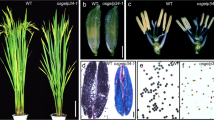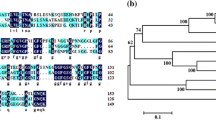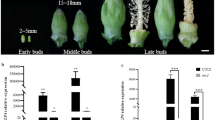Abstract
In flowering plants, male gametophytes are generated in anthers from microsporocytes. However, more evidence is needed to reveal the genetic mechanisms which regulate the differentiation and interaction of these highly specialized cells in anthers. Here we report the characterization of a series of male-sterile cotton (Gossypium hirsutum) mutants, including mutants with normal fertility, semi-sterility and complete sterility. These mutants are forms of transgenic cotton containing RNAi vectors with partial cDNA fragments of GhSERK1. The GhSERK1 gene encodes a putative leucine-rich repeat receptor protein kinase (LRR-RLK), and generally has 11 domains. In previous research, we found plants containing GhSERK1 produce an abundance of male reproductive tissue. In this paper, three RNAi constructs were designed separately to analyze its function in anther. After the three RNAi vectors were transformed into the cotton, transgenic plants with the specialized fragment exhibited normal fertility or the pollen energy decreased slightly, as ones with the homologous fragments exhibited various degrees of male sterility with different expression levels of GhSERK1 mRNA. In conclusion, for the transgenic plants with conserved fragments, lower expression levels of GhSERK1 mRNA were in transgenic plants, and a higher degree of male sterility was observed. Taking together, these findings demonstrate the GhSERK1 gene has a role in the development of anthers, especially in the formation of pollen grains. Also, we infer there must be another homolog of GhSERK1 in cotton, and both of GhSERK1 and its homolog function redundantly as important control points in controlling anther pollen production.










Similar content being viewed by others
Abbreviations
- LRR-RLK:
-
Leucine-rich repeat receptor protein kinase
- SERK:
-
Somatic embryogenesis receptor-like kinases
- EMS1:
-
Excess microsporocytes1
- EXS:
-
Extra sporogenous cells
- TPD1:
-
Tapetum determinant1
- BAM1/2:
-
Barely any meristem1/2
- RPK2:
-
Receptor-like protein kinase1
- SPP:
-
Ser-Pro-Pro motif
- TM domain:
-
Transmembrane domain
- Nt:
-
Nucleotide
References
Goldberg RB, Beals TP, Sanders PM (1993) Anther development: basic principles and practical applications. Plant Cell 5(10):1217–1229
Mariani C, Beuckeleer MD, Truettner J, Leemans J, Goldberg RB (1990) Induction of male sterility in plants by a chimaeric ribonuclease gene. Nature 347:737–741
Mariani C, Gossele V, Debeuckeleer M, Deblock M, Goldberg RB, Degreef W, Leemans J (1992) A chimaeric ribonuclease-inhibitor gene restores fertility to male sterile plants. Nature 357(6377):384–387
Canales C, Bhatt AM, Scott R, Dickinson H (2002) EXS, a putative LRR receptor kinase, regulates male germline cell number and tapetal identity and promotes seed development in Arabidopsis. Curr Biol 12(20):1718–1727
Zhao DZ, Wang GF, Speal B, Ma H (2002) The EXCESS MICROSPOROCYTES1 gene encodes a putative leucine-rich repeat receptor protein kinase that controls somatic and reproductive cell fates in the Arabidopsis anther. Genes Dev 16(15):2021–2031
Schmidt ED, Guzzo F, Toonen MA, de Vries SC (1997) A leucine-rich repeat containing receptor-like kinase marks somatic plant cells competent to form embryos. Development 124(10):2049–2062
Albrecht C, Russinova E, Hecht V, Baaijens E, de Vries S (2005) The Arabidopsis thaliana SOMATIC EMBRYOGENESIS RECEPTOR-LIKE KINASES1 and 2 control male sporogenesis. Plant Cell 17(12):3337–3349
Colcombet J, Boisson-Dernier A, Ros-Palau R, Vera CE, Schroeder JI (2005) Arabidopsis SOMATIC EMBRYOGENESIS RECEPTOR KINASES1 and 2 are essential for tapetum development and microspore maturation. Plant Cell 17(12):3350–3361
Yang SL, Xie LF, Mao HZ, Puah CS, Yang WC, Jiang L, Sundaresan V, Ye D (2003) Tapetum Determinant1 is required for cell specialization in the Arabidopsis anther. Plant Cell 15(12):2792–2804
DeYoung BJ, Bickle KL, Schrage KJ, Muskett P, Patel K, Clark SE (2006) The CLAVATA1-related BAM1, BAM2 and BAM3 receptor kinase-like proteins are required for meristem function in Arabidopsis. Plant J 45(1):1–16
Hord CL, Chen C, Deyoung BJ, Clark SE, Ma H (2006) The BAM1/BAM2 receptor-like kinases are important regulators of Arabidopsis early anther development. Plant Cell 18(7):1667–1680
Mizuno S, Osakabe Y, Maruyama K, Ito T, Osakabe K, Sato T, Shinozaki K, Yamaguchi-Shinozaki K (2007) Receptor-like protein kinase 2 (RPK2) is a novel factor controlling anther development in Arabidopsis thaliana. Plant J 50(5):751–766
Hecht V, Vielle-Calzada JP, Hartog MV, Ed Schmidt DL, Boutilier K, Grossniklaus U, de Vries SC (2001) The Arabidopsis somatic embryogenesis receptor kinase 1 gene is expressed in developing ovules and embryos and enhances embryogenic competence in culture. Plant Physiol 127(3):803–816
Salaj Jan, von Recklinghausen Iris R, Hecht Valerie, de Vries Sacco C, Schel Jan HN, van Lammeren Andre′ AM (2008) AtSERK1 expression precedes and coincides with early somatic embryogenesis in Arabidopsis thaliana. Plant Physiol Biochem 46:709–714
Baudino S, Hansen S, Brettschneider R, Hecht VF, Dresselhaus T, Lörz H, Dumas C, Rogowsky PM (2001) Molecular characterisation of two novel maize LRR receptor-like kinases, which belong to the SERK gene family. Planta 213(1):1–10
Shimada T, Hirabayashi T, Endo T, Fujii H, Kita M, Omura M (2005) Isolation and characterization of the somatic embryogenesis receptor-like kinase gene homologue (CitSERK1) from Citrus unshiu Marc. Sci Hortic 103(2):233–238
de Oliveira Santos M, Romano E, Yotoko KSC, Tinoco MLP, Dias BBA, Aragão FJL (2005) Characterisation of the cacao somatic embryogenesis receptor-like kinase (SERK) gene expressed during somatic embryogenesis. Plant Sci 168(3):723–729
Li JM, Chory J (1997) A putative leucine-rich repeat receptor kinase involved in brassinosteroid signal transduction. Cell 90(5):929–938
Noguchi T, Fujioka S, Choe S, Takatsuto S, Yoshida S, Yuan H, Feldmann KA, Tax FE (1999) Brassinosteroid-insen-sitive dwarf mutants of Arabidopsis accumulate brassinosteroids. Plant Physiol 121(3):743–752
He K, Gou X, Yuan T, Lin H, Asami T, Yoshida S, Russell SD, Li J (2007) BAK1 and BKK1 regulate brassinosteroid-dependent growth and brassinosteroid-independent cell-death pathways. Curr Biol 17(13):1109–1115
Hu H, Xiong L, Yang Y (2005) Rice SERK1 gene positively regulates somatic embryogenesis of cultured cell and host defense response against fungal infection. Planta 222(1):107–117
Kemmerling B, Schwedt A, Rodriguez P, Mazzotta S, Frank M, Qamar SA, Mengiste T, Betsuyaku S, Parker JE, Müssig C, Thomma BP, Albrecht C, de Vries SC, Hirt H, Nürnberger T (2007) The BRI1-associated kinase 1, BAK1, has a brassinolide-independent role in plant cell-death control. Curr Biol 17(13):1116–1122
Santos MO, Romano E, Vieira LS, Baldoni AB, Aragao FJ (2009) Suppression of SERK gene expression affects fungus tolerance and somatic embryogenesis in transgenic lettuce. Plant Biol 11(1):83–89
Khan IA, Awan FS, Ahmad A, Khan AA (2004) A modified mini-Prep method for economical and rapid extraction of genomic DNA in plants. Plant Mol Biol Report 22(1):89a–89e
Livak KJ, Schmittgen TD (2001) Analysis of relative gene expression data using real-time quantitative PCR and the 2−ΔΔCT method. Methods 25(4):402–408
Nolan KE, Irwanto RR, Rose RJ (2003) Auxin up-regulates MtSERK1 expression in both Medicago truncatula root-forming and embryogenic cultures. Plant Physiol 133(1):218–230
Ito Y, Takaya K, Kurata N (2005) Expression of SERK family receptor-like protein kinase gene in rice. Biochem Biophys Acta 1730(3):253–258
Song D, Li G, Song F, Zheng Z (2008) Molecular characterization and expression analysis of OsBISERK1, a gene encoding a leucine-rich repeat receptor-like kinase, during disease resistance responses in rice. Mol Biol Rep 35(2):275–283
Singla B, Tyagi AK, Khurana JP, Khurana P (2007) Analysis of expression profile of selected genes expressed during auxin-induced somatic embryogenesis in leaf base system of wheat (Triticum aestivum) and their possible interactions. Plant Mol Biol 65(5):677–692
Schellenbaum P, Jacques A, Maillot P, Bertsch C, Mazet F, Farine S, Walter B (2008) Characterization of VvSERK1, VvSERK2, VvSERK3 and VvL1L genes and their expression during somatic embryogenesis of grapevine (Vitis vinifera L.). Plant Cell Rep 27(12):1799–1809
Zakizadeh H, Bjarne M, Stummann, Lütken H, Müller R (2010) Isolation and characterization of four somatic embryogenesis receptor-like kinase (RhSERK) genes from miniature potted rose (Rosa hybrida cv. Linda). Plant Cell Tiss Organ Cult 101(3):331–338
Shi YL, Zhang R, Wu XP, Meng ZG, Guo SD (2012) Cloning and characterization of a Somatic Embryogenesis Receptor-Like Kinase Gene in cotton (Gossypium hirsutum). Journal of Integrative Agriculture 11(6):898–909
Schiefthaler U, Balasubramanian S, Sieber P, Chevalier D, Wisman E, Schneitz K (1999) Molecular analysis of NOZZLE, a gene involved in pattern formation and early sporogenes is during sex organ development in Arabidopsis thaliana. Proc Natl Acad Sci USA 96(20):11664–11669
Yang WC, Ye D, Xu J, Sundaresan V (1999) The SPOROCYTELESS gene of Arabidopsis is required for initiation of sporogenesis and encodes a novel nuclear protein. Genes Dev 13(16):2108–2117
Liu X, Huang J, Parameswaran S, Ito T, Seubert B, Auer M, Rymaszewski A, Jia G, Owen HA, Zhao D (2009) The SPOROCYTELESS/NOZZLE Gene Is Involved in Controlling Stamen Identity in Arabidopsis. Plant Physiol 151(3):1401–1411
Shiu SH, Bleecker AB (2001) Receptor-like kinases from Arabidopsis form a monophyletic gene family related to animal receptor kinases. Proc Natl Acad Sci USA 98(19):10763–10768
Jia G, Liu X, Owen HA, Zhao D (2008) Signaling of cell fate determination by the TPD1 small protein and EMS1 receptor kinase. Proc Natl Acad Sci USA 105(6):2220–2225
Acknowledgments
This work was supported by the Research Initiative of Development of Transgenic Cotton Plants funded by Ministry of Agriculture of the People’s Republic of China (2008ZX08005-004).
Conflict of interest
The authors declare that they have no conflict of interest.
Author information
Authors and Affiliations
Corresponding author
Additional information
Ya-li Shi and San-dui Guo contributed equally to this study.
Electronic supplementary material
Supplementary Fig. 1 Sequence Alignment of SERKs’ cDNAs, corresponding to the SPP domain and TM domain. The 834-bp-long genomic fragment of GhSERK1corresponded to its CDS sequence 600–780 bp. Its identity was very low, and the 834-bp-long genomic fragment contained two introns. So it could prove the GhSERK1 specificity of the probe used for Southern blotting. AtSERK1: gi_145337426; AtSERK2: gi_145336393; AtSERK3: gi_14573458; AtSERK4: gi_145359963; AtSERK5: gi_42569012; DcSERK: gi_2224910; MtSERK: gi_24935325; StSERK1: gi_126466787; CuSERK1: gi_50657182; OsSERK: gi_40253582; PpSERK1: gi_52626612; PpSERK2: gi_52626610; ZmSERK1: gi_13897317; ZmSERK3: gi_13897321; GhSERK1: HQ621831 (425–2,308 bp)
Rights and permissions
About this article
Cite this article
Shi, Yl., Guo, Sd., Zhang, R. et al. The role of Somatic embryogenesis receptor-like kinase 1 in controlling pollen production of the Gossypium anther. Mol Biol Rep 41, 411–422 (2014). https://doi.org/10.1007/s11033-013-2875-x
Received:
Accepted:
Published:
Issue Date:
DOI: https://doi.org/10.1007/s11033-013-2875-x




